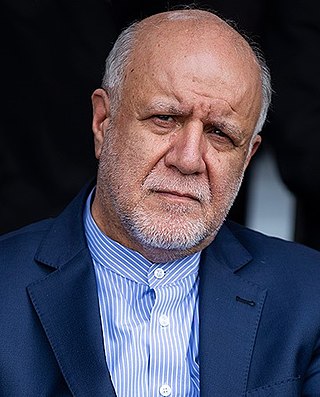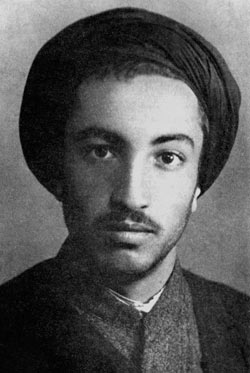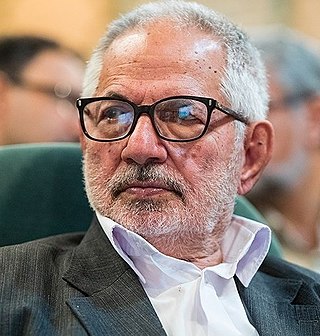Related Research Articles

Sayyed Abol-Ghasem Mostafavi-Kashani was an Iranian politician and Shia Marja. He played an important role in the 1953 coup in Iran and the overthrow of Prime Minister Mohammad Mosaddegh.

Mohammad-Ali Rajai was an Iranian politician who served as the second president of Iran from 2 August 1981 until his assassination four weeks later. Before his presidency, Rajai had served as prime minister under Abolhassan Banisadr, while concurrently occupying the position of foreign affairs minister from 11 March 1981 to 15 August 1981. He died in a bombing on 30 August 1981 along with then-prime minister Mohammad-Javad Bahonar.

Mohammad Reza Aref is an Iranian engineer, academic and reformist politician who is the eighth and current first vice president of Iran since 2024, under President Masoud Pezeshkian. He is also currently member of the Expediency Discernment Council since 2002.

Mehdi Bazargan was an Iranian scholar, academic, long-time pro-democracy activist and head of Iran's interim government.

Bijan Namdar Zangeneh is an Iranian politician, who served as minister, at different cabinets after the Islamic Revolution, for 30 years. He lately served as Minister of Petroleum from 2013 to 2021 in the cabinet led by Hassan Rouhani.

The Islamic Republican Party was formed in 1979 to assist the Iranian Revolution and Ayatollah Khomeini in their goal to establish theocracy in Iran. It was disbanded in 1987 due to internal conflicts.

Abdolhossein Hazhir was an Iranian politician who served as the Prime Minister of Iran under Mohammad Reza Pahlavi in 1948, having been a minister 10 times. One of his posts was the minister of finance.

Ali Razmara, also known as Haj Ali Razmara, was a military leader and prime minister of Iran.

Sayyid Mojtaba Mir-Lohi, more commonly known as Navvab Safavi, was an Iranian Shia cleric and founder of the Fada'iyan-e Islam group. He played a role in assassinations of Abdolhossein Hazhir, Haj Ali Razmara and Ahmad Kasravi. On 22 November 1955, after an unsuccessful attempt to assassinate Hosein Ala', Navvab Safavi and some of his followers were arrested. In January 1956, Safavi and three other members of Fada'iyan-e Islam were sentenced to death and executed.

Hossein Fatemi was an Iranian scholar. A close associate of Prime Minister Mohammad Mosaddegh, he proposed nationalization of Iranian oil and gas assets. Initially a journalist, he served as minister of foreign affairs from 1951 to 1953. After the 1953 coup d'état toppled the government of Mosaddegh, Fatemi was arrested, tortured, and convicted by a military court of "treason against the Shah", and executed by a firing squad.

Hasan Ali Mansur was an Iranian politician who served as Prime Minister from 1964 to 1965. He served during the White Revolution of the Shah Mohammad Reza Pahlavi and was assassinated by a member of the Fada'iyan-e Islam.
Fadayan-e Islam is a Shia fundamentalist group in Iran with a strong activist political and terrorist orientation. The group was founded in 1946, and registered as a political party in 1989. It was founded by a theology student, Navvab Safavi. Safavi sought to purify Islam in Iran by ridding it of 'corrupting individuals' by means of carefully planned assassinations of certain leading intellectual and political figures.

The Council of the Islamic Revolution was a group formed by Ayatollah Ruhollah Khomeini to manage the Iranian Revolution on 10 January 1979, shortly before he returned to Iran. "Over the next few months there issued from the council hundreds of rulings and laws, dealing with everything from bank nationalization to nurses' salaries." Its existence was kept a secret during the early, less secure time of the revolution, and its members and the exact nature of what the council did remained undisclosed to the public until early 1980. Some of the council's members like Motahhari, Taleqani, Bahonar, Beheshti, Qarani died during Iran–Iraq War or were assassinated by the MKO during the consolidation of the Iranian Revolution. Most of those who remained were put aside by the regime.
In 1949 a Constituent Assembly was held in Iran to modify the Persian Constitution of 1906. Shah Mohammad Reza Pahlavi convened the assembly in April; he sought a royal prerogative giving him the right to dismiss the parliament, providing that new elections were held to form a new parliament. He also specified a method for future amendments to the Constitution. The amendments were made in May 1949 by unanimous vote of the Constituent Assembly.

Parliamentary elections were held in Iran in 1950.

The nationalization of the Iranian oil industry resulted from a movement in the Iranian parliament (Majlis) to seize control of Iran's oil industry, which had been run by private companies, largely controlled by foreign interests. The legislation was passed on March 15, 1951, and was verified by the Majlis on March 17, 1951. The legislation led to the nationalization of the Anglo-Iranian Oil Company (AIOC) and the formation of the National Iranian Oil Company (NIOC). The movement was led by Mohammad Mosaddegh, a member of the Majlis for the National Front and future prime minister of Iran. The movement to nationalize the oil industry was the reaction to the following concessions made by Iran to foreign powers: the Reuter concession of 1872, proceeding letter,D'Arcy Concession?] the 1933 agreement between the Iranian government and AIOC, and the Gas-golshaian[?] contract. According to the political scientist Mark J. Gasiorowski, the oil nationalization movement had two major results: the establishment of a democratic government and the pursuit of Iranian national sovereignty.

Mohammad-Mehdi Abdekhodaei is an Iranian conservative activist.

Abdollah Hedayat (1899–1968) was an army officer who served as the chief of general staff at the Imperial Iran Army.

The cabinet led by Haj Ali Razmara was formed on 26 June 1950 and succeeded the cabinet led by Ali Mansur who was in office between April and June 1950. Razmara was a lieutenant general at the imperial army and was serving as the chief of the general staff when he was appointed by the Shah Mohammad Reza Pahlavi as the prime minister. It was the 33rd and first military cabinet in Iran since 1924. Behrooz Moazami also argues that it was one of the cabinets which did not follow the political agenda of the Shah in addition to the cabinets of Mohammad Mosaddegh and those of Ahmad Qavam in the Pahlavi rule. The Razmara cabinet ended on 11 March 1951 three days after the assassination of the prime minister.
The cabinet led by Hossein Ala' was formed on 20 March 1951 two weeks after the assassination of Prime Minister Haj Ali Razmara. The cabinet was given vote of confidence at the Majlis on 17 April 1951. However, the tenure of the cabinet was very short and lasted only until 27 April when Hossein Ala' resigned from office due to threats of the Fada'iyan-e Islam members who had murdered Haj Ali Razmara. Another reason for the resignation of the cabinet was the ratification of the oil nationalization bill. It was succeeded by the cabinet formed by Mohammad Mosaddegh in late April.
References
- 1 2 3 4 5 6 7 8 9 Malcolm Yapp, ed. (2002). British Documents on Foreign Affairs: Reports and Papers from the Foreign Office Confidential Print. Vol. 9. Frederick, MD: University Publications of America. p. 132. ISBN 978-1-55655-765-1.
- ↑ Cyrus Vakili-Zad (Spring 1990). "Organization, Leadership and Revolution: Religiously-Oriented Opposition in the Iranian Revolution of 1978-1979". Journal of Conflict Studies. 10 (2): 14.
- ↑ "Martial Law In Persia". The Times . Tehran. 21 March 1951. Retrieved 26 February 2023.
- ↑ Hassan Mohammadi Nejad (1970). Elite-Counterelite Conflict and the Development of a Revolutionary Movement: The Case of Iranian National Front (PhD thesis). Southern Illinois University Carbondale. p. 89. ISBN 9798657957457. ProQuest 302536657.
- ↑ "Iran Official Dies from Bullet Wound". The Free Lance–Star . Tehran. 26 March 1951. Retrieved 23 April 2022.
- ↑ Mosa Zahed (2017). "The Evolution and Ascension of Iran's Terror Apparatus". In Paulo Casaca; Siegfried O. Wolf (eds.). Terrorism Revisited: Islamism, Political Violence and State-Sponsorship. Cham: Springer. p. 63. ISBN 978-3-319-55690-1.